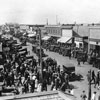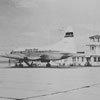The Town of Grande Prairie (1918-1945)

Grande Prairie, having been incorporated as a village in 1914, received its first railway, the Edmonton, Dunvegan and British Columbia Railway in 1916.
Grande Prairie’s population continued to climb so that by 1919, its population surpassed the 1,000 mark (1,040) and Grande Prairie was incorporated as a town. The next year, the Town Hall-Fire Hall was erected. Between 1919 and 1921, nearly 175 buildings were built at the cost of over $500,000. Among these buildings were five new banks: the Merchants Bank and the Bank of Montreal opened in 1918, followed the next year by the Imperial Bank, the Canadian Bank of Commerce and the Royal Bank.

Grande Prairie was the most important retail and wholesale centre north of Edmonton. Its agricultural industries, particularly flour milling, were growing. Imperial Oil made the town its northern centre as it began drilling for oil in the Peace River region. Also, the Dalen Brickyward was established south of Grande Prairie in 1920, allowing the town to build modern brick structures. But, other than agriculture, the main industry in Grande Prairie remained lumber. The town had two important lumber companies at the time, the Buffalo Lakes Lumber Company and the Beaver Lumber Company.
Industrial growth was accompanied by residential growth; veterans returning from the war took land in Peace River Country, offered to them by the Dominion Government’s Soldiers’ Settlement Board. Between 1919 and 1921, there were 919 homesteading applications from returning soldiers, and 1929 from regular homesteaders.

However, Grande Prairie’s post-war growth was not sustainable. During the 1920s, Grande Prairie went into recession and suffered a minor loss in population. The majority of the depopulation occurred in rural areas; the mechanization of farming was putting small farms out of business. Also, Grande Prairie, and the whole of Alberta, was suffering a dry spell in the early 1920s accompanied by falling wheat prices. Struggling farmers were also hit with high freight rates and inconsistent service by the E, D, & BC railway. Homestead cancellations outnumbered applications for the first time in the history of the area. In 1926, Grande Prairie’s population fell bellow the 1000, settling at 917. But after 1926, the economy of the Peace River area was picking up; new wheat markets opened up and ideal conditions lead to high yields throughout the district. By the 1928 season, homestead applications reached 2,268, and they stayed high through the rest of the decade. 1929 was a very good year for the Town of Grande Prairie, which saw the development St. Joseph’s Catholic School, the Central Park High School, and a new hospital building.

Peace River Country was one of the better places to be in Alberta during the Great Depression of the 1930s. Many farmers in the south were driven north because of dust bowl conditions, while farmers of Grande Prairie and area grew bountiful crops. By 1931, the Town of Grande Prairie counted 1,464 residents, with 13,000 in the surrounding district. Of course, the financial conditions of the 1930s put great strain on the residents of Grande Prairie and area as grain prices remained low, freight rates high, and unemployment a concern in some sectors. Farm foreclosures and business bankruptcies became commonplace. But, relative to other Albertan communities, Grande Prairie required low amounts of relief, and no one starved in the region due to plentiful crops. Some industries even grew, particularly out in the coal mines at Wapiti.
The Town of Grande Prairie saw some important construction during the depression. The first business college in town was built in 1932. Building permits exceeded $70,000 in 1935—a considerable jump from $3,415 in the previous year. Meanwhile, the price for wheat rose over the dollar mark. The first highway service station in the region was built out in Wembley. Also, Grande Prairie’s Peace River Bible Institute was opened.

During the Second World War, Grande Prairie became home to a Militia Training Centre on the southern edge of town; this became the home of Grande Prairie’s militia unit, nicknamed D company. The war effectively wiped out the town’s unemployment; many young men and women of Grande Prairie enlisted in the war effort, freeing up jobs. In addition, there were new jobs to be had in the war industries and in all the businesses that profited from these industries. Mainly, the town benefited from the building of the Alaska Highway by the Americans. Many of the 16,000 civilians employed in its construction were from Grande Prairie and area. During the build, 500 Canadian and American military personnel were stationed at the Grande Prairie airport, which was taken over by the Royal Canadian Air Force. There was also a high demand for farmers during harvest; 85 farmers from the Peace River area were sent to help Central Albertan farmers with their harvests, after their own harvests had been completed. By 1944, the war was winding down and the Militia Training Centre had closed.
But Grande Prairie’s economy was far from winding down. Grande Prairie was set to enter a new era of growth as the end of the war paved the way to Grande Prairie’s next great building boom.
References
Campbell, Isabel M. Grande Prairie: Capitol of the Peace. City of Grande Prairie, 1968.
Leonard, David W. The Grande Prairie of the Great Northland: The Evolution of a County: 1805-1951. County of Grande Prairie, Alberta #1, 2005.



